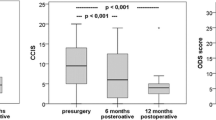Abstract
Laparoscopic ventral mesh rectopexy (VMR) has become a popular surgical technique for treating women with full-thickness rectal prolapse with a low recurrence rate, as demonstrated by several studies. In addition, it is increasingly applied to female patients with obstructive defecation syndrome (ODS) caused by intussusception ± rectocele. Functional improvement can be achieved in a high number of patients with ODS, but expectations need to be discussed carefully, as a few patients may not benefit at all. In particular, long-term data on functional outcome and complications following laparoscopic VMR for ODS are still lacking in the literature. Notably, laparoscopic VMR appears to be better than alternative operations for prolapse, intussusception, and rectocele in terms of efficacy, recurrence rates, and adverse effects, but there is a lack of evidence directly comparing techniques through randomized controlled trials; thus, its exact role stills needs to be defined in the future.
Similar content being viewed by others
References
Consten EC, van Iersel JJ, Verheijen PM, Broeders IA, Wolthuis AM, D’Hoore A. Long-term outcome after laparoscopic ventral mesh rectopexy: an observational study of 919 consecutive patients. Ann Surg. 2015;262(5):742–747; discussion 747–748. doi:10.1097/SLA.0000000000001401.
Makela-Kaikkonen JK, Rautio TT, Koivurova S, Paakko E, Ohtonen P, Biancari F, et al. Anatomical and functional changes to the pelvic floor after robotic versus laparoscopic ventral rectopexy: a randomised study. Int Urogynecol J. 2016;27(12):1837–45. doi:10.1007/s00192-016-3048-y.
Van Iersel JJ, Paulides TJ, Verheijen PM, Lumley JW, Broeders IA, Consten EC. Current status of laparoscopic and robotic ventral mesh rectopexy for external and internal rectal prolapse. World J Gastroenterol. 2016;22(21):4977–87. doi:10.3748/wjg.v22.i21.4977.
Boons P, Collinson R, Cunningham C, Lindsey I. Laparoscopic ventral rectopexy for external rectal prolapse improves constipation and avoids de novo constipation. Colorectal Dis. 2010;12(6):526–32. doi:10.1111/j.1463-1318.2009.01859.x.
Guzman Rojas R, Kamisan Atan I, Shek KL, Dietz HP. The prevalence of abnormal posterior compartment anatomy and its association with obstructed defecation symptoms in urogynecological patients. Int Urogynecol J. 2016;27(6):939–44. doi:10.1007/s00192-015-2914-3.
Van Iersel JJ, de Witte CJ, Verheijen PM, Broeders IA, Lenters E, Consten EC, et al. Robot-assisted sacrocolporectopexy for multicompartment prolapse of the pelvic floor: a prospective cohort study evaluating functional and sexual outcome. Dis Colon Rectum. 2016;59(10):968–74. doi:10.1097/DCR.0000000000000669.
Haylen BT, de Ridder D, Freeman RM, Swift SE, Berghmans B, Lee J, et al. An International Urogynecological Association (IUGA)/International Continence Society (ICS) joint report on the terminology for female pelvic floor dysfunction. Int Urogynecol J. 2010;21(1):5–26. doi:10.1007/s00192-009-0976-9.
Powar MP, Ogilvie JW Jr, Stevenson AR. Day-case laparoscopic ventral rectopexy: an achievable reality. Colorectal Dis. 2013;15(6):700–6. doi:10.1111/codi.12110.
Evans C, Stevenson AR, Sileri P, Mercer-Jones MA, Dixon AR, Cunningham C, et al. A multicenter collaboration to assess the safety of laparoscopic ventral rectopexy. Dis Colon Rectum. 2015;58(8):799–807. doi:10.1097/DCR.0000000000000402.
Smart NJ, Pathak S, Boorman P, Daniels IR. Synthetic or biological mesh use in laparoscopic ventral mesh rectopexy—a systematic review. Colorectal Dis. 2013;15(6):650–4. doi:10.1111/codi.12219.
Van der Hagen SJ, van Gemert WG, Soeters PB, de Wet H, Baeten CG. Transvaginal posterior colporrhaphy combined with laparoscopic ventral mesh rectopexy for isolated grade III rectocele: a prospective study of 27 patients. Colorectal Dis. 2012;14(11):1398–402. doi:10.1111/j.1463-1318.2012.03023.x.
Gosselink MP, Joshi H, Adusumilli S, van Onkelen RS, Fourie S, Hompes R, et al. Laparoscopic ventral rectopexy for faecal incontinence: equivalent benefit is seen in internal and external rectal prolapse. J Gastrointest Surg. 2015;19(3):558–63. doi:10.1007/s11605-014-2696-9.
Samaranayake CB, Luo C, Plank AW, Merrie AE, Plank LD, Bissett IP. Systematic review on ventral rectopexy for rectal prolapse and intussusception. Colorectal Dis. 2010;12(6):504–12. doi:10.1111/j.1463-1318.2009.01934.x.
Gladman MA, Scott SM, Williams NS, Lunniss PJ. Clinical and physiological findings, and possible aetiological factors of rectal hyposensitivity. Br J Surg. 2003;90(7):860–6. doi:10.1002/bjs.4103.
Engel AF, Kamm MA. The acute effect of straining on pelvic floor neurological function. Int J Colorectal Dis. 1994;9(1):8–12.
Saldana Ruiz N, Kaiser AM. Fecal incontinence—challenges and solutions. World J Gastroenterol. 2017;23(1):11–24. doi:10.3748/wjg.v23.i1.11.
Riss S, Stift A. Surgery for obstructed defecation syndrome—is there an ideal technique. World J Gastroenterol. 2015;21(1):1–5. doi:10.3748/wjg.v21.i1.1.
Liu WC, Wan SL, Yaseen SM, Ren XH, Tian CP, Ding Z, et al. Transanal surgery for obstructed defecation syndrome: literature review and a single-center experience. World J Gastroenterol. 2016;22(35):7983–98. doi:10.3748/wjg.v22.i35.7983.
Jayne DG, Schwandner O, Stuto A. Stapled transanal rectal resection for obstructed defecation syndrome: one-year results of the European STARR registry. Dis Colon Rectum. 2009;52(7):1205–1212; discussion 1212–1204. doi:10.1007/DCR.0b013e3181a9120f.
Heriot AG, Skull A, Kumar D. Functional and physiological outcome following transanal repair of rectocele. Br J Surg. 2004;91(10):1340–4. doi:10.1002/bjs.4543.
Nieminen K, Hiltunen KM, Laitinen J, Oksala J, Heinonen PK. Transanal or vaginal approach to rectocele repair: a prospective, randomized pilot study. Dis Colon Rectum. 2004;47(10):1636–42.
Author information
Authors and Affiliations
Corresponding author
Ethics declarations
Conflicts of interest
None.
Rights and permissions
About this article
Cite this article
Riss, S., Winstanley, J. & Collie, M. Laparoscopic ventral mesh rectopexy for obstructive defecation syndrome: still the way to go?. Int Urogynecol J 28, 979–981 (2017). https://doi.org/10.1007/s00192-017-3378-4
Received:
Accepted:
Published:
Issue Date:
DOI: https://doi.org/10.1007/s00192-017-3378-4




